Cuando se trata de dar forma y moldear metal, pocas máquinas son tan versátiles e indispensables como la máquina formadora de rollos. Si trabaja en el sector de la construcción o la fabricación, o simplemente siente curiosidad por la maquinaria industrial, es fundamental que conozca la función y la eficacia de las perfiladoras. En esta guía detallada, le explicaremos todo lo que necesita saber: qué hacen las perfiladoras, los distintos tipos, sus procesos de trabajo e incluso cómo elegir el mejor proveedor.
Tanto si está buscando información como si está dispuesto a invertir en esta máquina, este artículo está diseñado para ofrecerle toda la información en un solo lugar. Así que, abróchate el cinturón y ¡a rodar!
¿Qué es una máquina formadora de rollos?
A máquina formadora de rollos es un equipo diseñado para dar forma de perfiles precisos a tiras planas de metal. Este proceso, denominado perfilado, consiste en hacer pasar el metal por una serie de rodillos consecutivos. Cada juego de rodillos dobla ligeramente el metal hasta conseguir la forma transversal deseada.
Este método es muy eficaz, especialmente para producir perfiles metálicos largos en grandes volúmenes. El perfilado se utiliza principalmente para materiales como acero, aluminio y cobrey se emplea ampliamente en la industria de la construcción para productos como láminas para tejados, paneles de paredy marcos de puertas.
Características principales de Perfilado Machina
- Proceso continuo de plegado
- Adecuado para perfiles largos
- Trabaja con metales como el acero, el aluminio y el cobre
- Alta eficacia de producción
- Mínimo desperdicio de material
- Personalizable para producir diferentes formas y tamaños
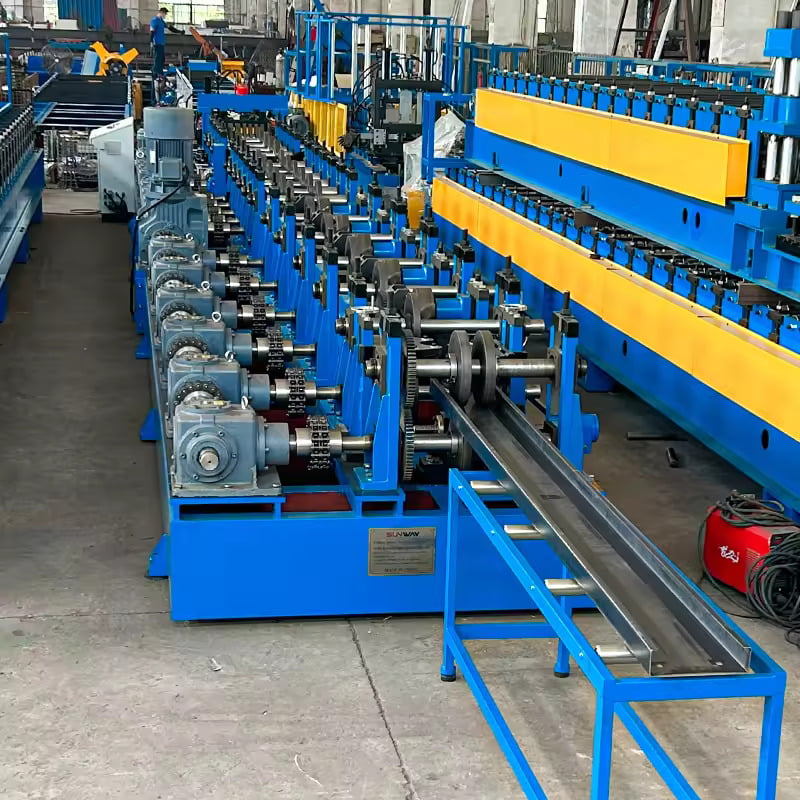
Tipos de perfiladoras: Adaptación a diferentes necesidades
Máquinas formadoras de rollos Existen de varias formas y tamaños, cada uno adaptado a aplicaciones específicas. A continuación, nos adentraremos en las tipos de perfiladoras, clasificadas por las funciones que desempeñan.
| Tipo de máquina | Descripción |
|---|---|
| Máquina monopedestal | Se utiliza un juego de rodillos, adecuado para formas sencillas con volúmenes de producción bajos. |
| Máquina multibastidor | Consta de varias estaciones de rodillos para perfiles más complejos y mayor rendimiento. |
| Perfilado portátil | Máquinas más pequeñas y móviles utilizadas directamente en las obras. |
| Perfilado de precisión | Máquinas de alta precisión utilizadas para piezas que requieren tolerancias estrechas. |
| Perfilado automático | Máquinas totalmente automatizadas con mínima intervención humana, que mejoran la productividad. |
| Perfilado de alta velocidad | Diseñada para altos índices de producción, adecuada para entornos de producción en serie. |
| Perfilado hidráulico | Utiliza la fuerza hidráulica para doblar materiales más pesados y gruesos. |
| Máquina servoaccionada | Equipada con servomotores para un control más preciso del proceso de conformado. |
| Perfiladora CNC | Controlada por ordenador, permite formas y perfiles altamente personalizables. |
| Perfilado a medida | Construidos específicamente para satisfacer las necesidades de los clientes, adaptados a diseños de productos únicos. |
Cada tipo de máquina tiene sus pros y sus contras, en función de los requisitos de su línea de producción. Saber qué modelo se adapta a sus necesidades puede ahorrarle tiempo, dinero y dolores de cabeza en el futuro.
¿Cómo funciona una perfiladora? El proceso completo
Quizá se pregunte: "¿Cómo funciona exactamente una perfiladora?". Es un proceso fascinante, que convierte el metal en bruto en perfiles precisos mediante un sistema continuo y automatizado. A continuación, desglosaremos todo el proceso de trabajo de una perfiladora:
Proceso de perfilado paso a paso
- Carga de material: En la máquina se introducen tiras o bobinas de metal en bruto. Los materiales más utilizados son el acero, el aluminio o el cobre.
- Enderezamiento inicial: El material pasa por un dispositivo de nivelación que lo aplana antes de que comience el conformado.
- Estaciones de rodillos: La banda pasa por varias estaciones de rodillos, cada una de las cuales dobla un poco más el metal hasta conseguir la forma final.
- Corte a medida: Una vez formado el perfil deseado, el material se corta a medida con herramientas de corte, que pueden ser una fresa mecánica o un láser.
- Recogida y apilado: Los productos acabados se recogen y apilan, listos para su envío o procesamiento posterior.
Esta operación sin fisuras es muy eficaz y minimiza los residuos, por lo que es perfecta para la producción en masa.
Componentes clave de una perfiladora y sus funciones
Cada pieza de una perfiladora desempeña un papel crucial para garantizar su funcionamiento correcto y eficaz. Echemos un vistazo a los componentes clave y sus funciones.
| Componente | Función |
|---|---|
| Rodillos | Responsable de dar forma al metal en el perfil deseado. |
| Alimentador de material | Introduce el metal en bruto en la máquina a un ritmo constante. |
| Unidad enderezadora | Aplana el material antes de que entre en las estaciones de rodillos. |
| Unidad de corte | Corta el metal conformado a la longitud requerida después de darle forma. |
| Motor (eléctrico o hidráulico) | Acciona los rodillos y otras partes mecánicas de la máquina. |
| Controlador (CNC o manual) | Controla el funcionamiento y ajusta parámetros como la velocidad y la fuerza. |
| Rollos guía | Mantenga la banda metálica alineada mientras se desplaza por la máquina. |
| desenrollador | Sujeta y libera la bobina metálica en la máquina. |
| Sistema de perforación | Perfora agujeros o ranuras en el material durante el proceso de conformado. |
-
 Máquina perfiladora de postes de viñedos
Máquina perfiladora de postes de viñedos -
 Máquina formadora de rollos Sigma Purlin de tamaño automático cambiable
Máquina formadora de rollos Sigma Purlin de tamaño automático cambiable -
 Máquina formadora de rollos de marco de gabinete eléctrico
Máquina formadora de rollos de marco de gabinete eléctrico -
 Máquina formadora de rollos de riel DIN
Máquina formadora de rollos de riel DIN -
 Máquina formadora de rollos de escalera de cable
Máquina formadora de rollos de escalera de cable -
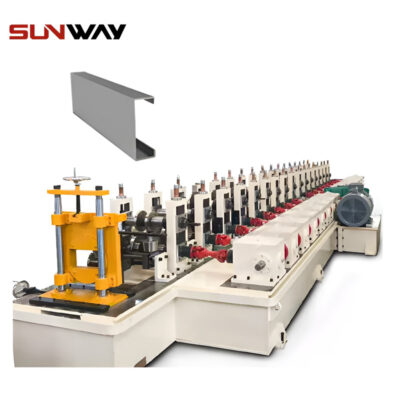 Máquina formadora de rollos de perfil en forma de C con soporte de montaje fotovoltaico
Máquina formadora de rollos de perfil en forma de C con soporte de montaje fotovoltaico -
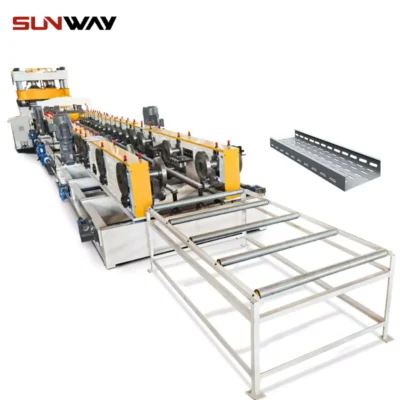 Máquina perfiladora de bandeja portacables
Máquina perfiladora de bandeja portacables -
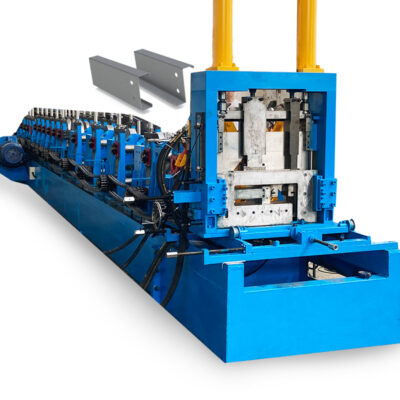 Laminación en frío del canal de la correa de la CZ que forma el perfil de acero galvanizado auto completo de la máquina
Laminación en frío del canal de la correa de la CZ que forma el perfil de acero galvanizado auto completo de la máquina -
 Máquina perfiladora de soporte de montaje fotovoltaico (perfil HAT / Omega)
Máquina perfiladora de soporte de montaje fotovoltaico (perfil HAT / Omega)
Velocidad y eficacia de la máquina: Qué esperar de las perfiladoras
Uno de los factores clave que hay que tener en cuenta al comprar un máquina formadora de rollos es su velocidad y eficacia. Esto es especialmente importante si trabaja en un entorno de producción de gran volumen. Veamos las velocidades típicas y cómo afectan a la productividad.
| Tipo de máquina | Velocidad media | Eficacia |
|---|---|---|
| Máquina monopedestal | 5-10 metros por minuto | Menor eficiencia, adecuada para pequeñas series de producción. |
| Máquina multibastidor | 20-30 metros por minuto | Alta eficiencia, lo mejor para tareas complejas y de gran volumen |
| Perfilado de alta velocidad | 40-100 metros por minuto | Extremadamente eficiente para la producción en masa. |
| Perfilado de precisión | 10-15 metros por minuto | Velocidades más lentas pero precisión extremadamente alta. |
| Perfilado hidráulico | 5-15 metros por minuto | Más lenta pero ideal para materiales pesados. |
Parámetros mecánicos personalizados para perfiladoras
Cada línea de producción es diferente, y por eso a menudo es necesaria la personalización. Puede ajustar varios parámetros mecánicos para satisfacer necesidades de fabricación específicas.
| Parámetro | Descripción |
|---|---|
| Grosor del material | Oscila entre 0,3 mm y 5 mm, según el tipo de metal. |
| Anchura del perfil | Puede variar en función de los requisitos del cliente; normalmente oscila entre 100 mm y 800 mm |
| Estaciones de conformado | El número de estaciones puede personalizarse en función de la complejidad del perfil. |
| Longitud de corte | Ajustable para producir productos de diferentes tamaños, normalmente de 0,5 metros a 12 metros. |
| Capacidad de perforación | Patrones de perforación personalizables para agujeros, ranuras o muescas. |
| Potencia del motor | Puede ajustarse en función del material y la velocidad de producción. |
| Tipo de controlador | Elija entre sistemas CNC, manuales o semiautomáticos. |
Aplicaciones de las perfiladoras: ¿Dónde se utilizan?
Las perfiladoras son versátiles y tienen una amplia gama de aplicaciones. He aquí una lista de sectores y productos en los que suelen utilizarse estas máquinas.
| Solicitud | Descripción |
|---|---|
| Tejados y paneles murales | Chapas onduladas utilizadas en la construcción para cubiertas y revestimientos murales. |
| Marcos de puertas y ventanas | Fabrica armazones para edificios residenciales e industriales. |
| Industria del automóvil | Crea piezas metálicas para bastidores y elementos estructurales de vehículos. |
| Conductos HVAC | Se utiliza en la fabricación de conductos para calefacción, ventilación y aire acondicionado. |
| Muebles de acero | Da forma a perfiles metálicos utilizados en mobiliario de oficina e industrial. |
| Armarios eléctricos | Fabrica armarios para sistemas eléctricos y armarios de control. |
| Marcos para paneles solares | Forma perfiles metálicos para el montaje de paneles solares en tejados. |
| Sistemas de almacenamiento | Crea estantes, estanterías y otras soluciones de almacenamiento. |
| Vallas y barandillas | Fabrica barreras y vallas de seguridad para carreteras y entornos industriales. |
| Bandejas de cables | Da forma metálica a bandejas que soportan el cableado eléctrico. |
Instalación, funcionamiento y mantenimiento de perfiladoras
Garantizar la instalación, el funcionamiento y el mantenimiento adecuados de una perfiladora es esencial para lograr eficacia y rendimiento a largo plazo.
| Proceso | Detalles |
|---|---|
| Instalación | Requiere una alineación adecuada de la máquina, conexiones eléctricas y configuración hidráulica. |
| Operación | Normalmente requiere operarios formados que comprendan las velocidades de avance del material y los controles de la máquina. |
| Mantenimiento | La lubricación periódica, la limpieza y la sustitución de los componentes desgastados son cruciales para la longevidad. |
| Medidas de seguridad | Incluya paradas de emergencia, protecciones de seguridad e inspecciones periódicas de la máquina. |
| Solución de problemas | Problemas como la desalineación del material o el desgaste de los rodillos pueden resolverse con una intervención a tiempo. |
Elegir al proveedor adecuado: Una decisión clave
A la hora de invertir en una perfiladora, elegir al proveedor adecuado puede marcar la diferencia. Aquí tiene un desglose de lo que debe tener en cuenta a la hora de elegir un proveedor.
| Factor | En qué fijarse |
|---|---|
| Precios | Compare precios de distintos proveedores. Las máquinas pueden oscilar entre $50.000 y $200.000. |
| Reputación | Investigue las opiniones de los clientes y la reputación del sector. |
| Asistencia y garantía | Busque proveedores que ofrezcan garantías ampliadas y un buen servicio posventa. |
| personalización | Asegúrese de que el proveedor puede satisfacer sus necesidades específicas de personalización. |
| Ubicación | Elija un proveedor que pueda ofrecer servicios de entrega y asistencia a tiempo. |
Proveedores y precios
| Proveedor | Gama de precios (USD) | Ubicación |
|---|---|---|
| Maquinaria Samco | $60,000 – $150,000 | Canadá |
| Perfilado Jupiter | $50,000 – $180,000 | India |
| Yoder | $100,000 – $250,000 | EE.UU. |
| Hangzhou Roll Forming | $45,000 – $120,000 | China |
| Grupo Formtek | $80,000 – $200,000 | EE.UU. |
Ventajas y desventajas de las perfiladoras: Ventajas y limitaciones
Como cualquier equipo industrial, las máquinas de perfilado tienen sus puntos fuertes y débiles. Veamos comparación de los pros y los contras.
Ventajas
- Alta eficiencia de producción: Una vez configurada, la máquina puede funcionar de forma continua, produciendo un gran volumen de perfiles metálicos con un tiempo de inactividad mínimo.
- Versatilidad: Puede utilizarse para una gran variedad de materiales y perfiles.
- Residuos mínimos: El proceso de perfilado continuo reduce los residuos de chatarra, por lo que resulta rentable y respetuoso con el medio ambiente.
- Precisión: Las máquinas son muy precisas y producen piezas con tolerancias muy ajustadas.
- personalización: Fácilmente personalizable para producir diferentes formas y tamaños para diversas industrias.
Limitaciones
- Alta Inversión Inicial: El coste inicial de la compra e instalación de una perfiladora puede ser considerable.
- Conocimientos especializados necesarios: Los operarios necesitan una formación adecuada para manejar las máquinas con eficacia.
- Producción limitada a grandes series: El perfilado es más adecuado para grandes series de producción, por lo que resulta menos eficaz para lotes pequeños.
Cómo elegir un proveedor de perfiladoras
Elegir el proveedor adecuado es crucial a la hora de invertir en una perfiladora. Estas son las consideraciones clave:
Factores a tener en cuenta al elegir un proveedor
- Reputación: Opte siempre por proveedores con un historial demostrado de suministro de máquinas de alta calidad.
- personalización: Asegúrese de que el proveedor puede satisfacer sus requisitos exactos en cuanto a diseño y rendimiento de la máquina.
- Servicios de apoyo: La asistencia posventa, que incluye la instalación, el mantenimiento y las reparaciones, es esencial.
- Precio: Aunque el precio es importante, no debe ser el único factor decisivo. Céntrate en el valor que ofrece el proveedor.
- Garantías: Un proveedor que ofrece una buena garantía indica confianza en su producto.
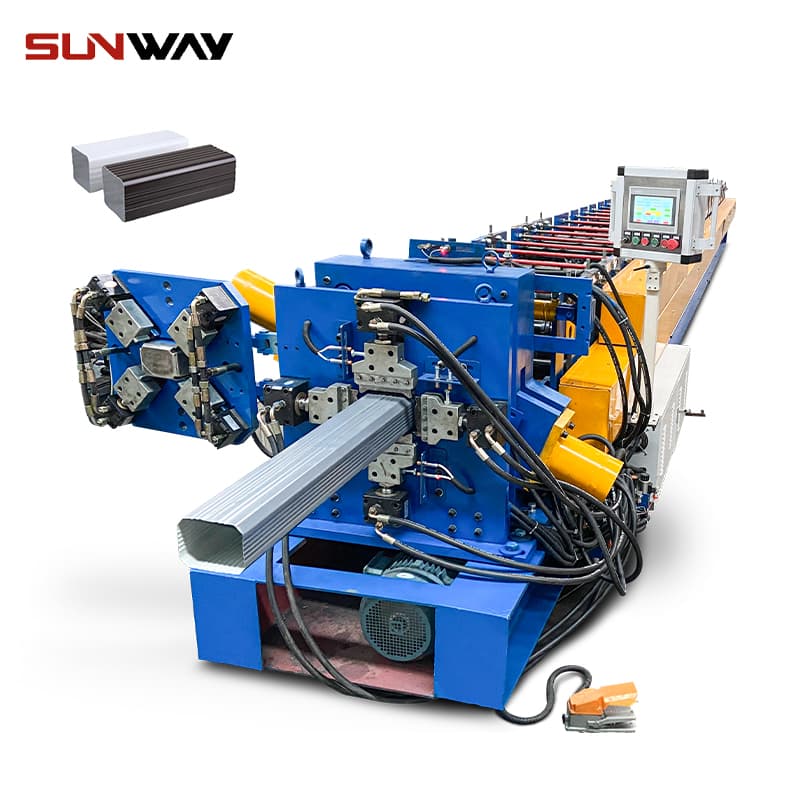
Preguntas frecuentes
| Pregunta | Respuesta |
|---|---|
| ¿Para qué sirve una perfiladora? | Una perfiladora se utiliza para dar forma a tiras planas de metal en los perfiles deseados para la construcción y la industria. |
| ¿Se puede personalizar el perfilado? | Sí, las perfiladoras pueden personalizarse para producir una amplia gama de formas, tamaños y diseños. |
| ¿Qué materiales pueden utilizarse en el perfilado? | Metales como el acero, el aluminio, el cobre y el zinc se utilizan habitualmente en las máquinas de perfilado. |
| ¿Cuál es la velocidad de las perfiladoras? | Las velocidades pueden oscilar entre 5 y 100 metros por minuto, dependiendo del tipo de máquina y material. |
| ¿Cuánto cuestan las perfiladoras? | Los precios varían mucho, desde $50.000 hasta más de $200.000, dependiendo de las capacidades de la máquina. |
Conclusión
A estas alturas, ya debería saber qué es un máquina formadora de rollos cómo funciona y si se adapta a sus necesidades de producción. Tanto si busca una producción de gran volumen como perfiles personalizados intrincados, existe una máquina para usted. La clave está en conocer sus necesidades específicas y combinarlas con la máquina y el proveedor adecuados.
Siguiendo esta guía, estará en el buen camino para tomar una decisión informada que beneficiará a su negocio en los años venideros.
Preguntas más frecuentes (FAQ)
1) ¿Qué tolerancias puede alcanzar una perfiladora moderna?
- Con soportes de precisión, herramientas de calidad y servoavances, puede esperar ±0,3-0,5 mm en dimensiones críticas y ±0,5-1,0 mm en longitud de corte a velocidades típicas. Las líneas de ultraprecisión con calibrado en línea pueden alcanzar ±0,2 mm en la altura del perfil.
2) ¿Cómo puedo elegir entre corte hidráulico, mecánico o servoaccionado?
- Hidráulico: robusto para calibres gruesos y fuerzas de cizallamiento elevadas. Mecánico (leva/volante): económico para calibres finos y medios. Servo corte volante: mejor para alta velocidad y tolerancias de longitud ajustadas con mínima rebaba.
3) ¿Puede una línea de perfilado procesar varios perfiles?
- Sí. Las opciones incluyen utillaje de cassette, bases en balsa y juegos de flores de cambio rápido. El cambio puede reducirse de 3-6 horas a 30-60 minutos con casetes prealineados y recetas digitales.
4) ¿Qué problemas de calidad de las bobinas afectan más a la chatarra?
- Ondulación de la corona/borde de la bobina, variación del espesor, tensión residual y lubricación deficiente de la superficie. Mitigar con especificaciones de planitud de entrada (I-unit/STM), mapeo de bobina y optimización de payoff/enderezador.
5) ¿Qué normas o certificaciones son importantes para la exportación?
- ISO 9001 (gestión de calidad), CE/UKCA (seguridad de las máquinas), IEC/UL/CSA (electricidad) y especificaciones específicas de producto como EN 1090 para componentes estructurales o AAMA/ASTM para perfiles de construcción. En el caso de la automoción, pueden exigirse PPAP e IATF 16949.
Tendencias del sector en 2025
- La optimización de la configuración basada en IA reduce el rechazo inicial en 20-35% utilizando gemelos digitales de flores en rollo.
- La adopción de los aceros recubiertos de Zn-Al-Mg (ZM120-ZM275) se acelera para los perfiles de construcción gracias a una vida útil a la corrosión de 2-4 veces superior a la del G90.
- Las HMI de bajo código y el cambio guiado reducen el tiempo de formación en ~30% y el tiempo de cambio en 40-60%.
- Los accionamientos energéticamente inteligentes y el sistema hidráulico regenerativo reducen los kWh/tonelada en 10-18%.
- La metrología óptica en línea se convierte en la corriente dominante para las comprobaciones dimensionales 100%, lo que permite el SPC en tiempo real y los ajustes automáticos del soporte.
- Resiliencia de la cadena de suministro: cada vez más compradores solicitan doble abastecimiento para herramientas y componentes electrónicos críticos, y especifican acuerdos de nivel de servicio locales.
Instantánea del mercado y la tecnología (2013-2025 est.)
| Métrica | 2023 | 2024 | 2025 (est.) | Notas/Fuentes |
|---|---|---|---|---|
| Mercado mundial de productos laminados (en miles de millones de USD) | 63.5 | 66.9 | 71.2 | Síntesis de informes del sector: MarketsandMarkets, Grand View Research |
| Velocidad media de la línea para perfiles de construcción (m/min) | 35 | 37 | 40 | Catálogos de proveedores, información sobre ferias |
| Plantas que utilizan el mantenimiento predictivo (%) | 28% | 35% | 45% | Deloitte Perspectivas de la industria 2024-2025 |
| Cuota de Zn-Al-Mg en bobinas de construcción (%) | 20% | 26% | 33% | ArcelorMittal Magnelis, Nippon Steel ZAM informes técnicos |
| Intensidad energética típica (kWh/tonelada formada) | 110 | 104 | 96 | Casos prácticos de OEM; referencias internas |
| Porcentaje de líneas con visión en línea/SPC (%) | 18% | 25% | 38% | Datos de los expositores de EMO/EuroBLECH |
Referencias clave:
- EN 10169, EN 10346 para aceros revestidos; AISI/COS para directrices de perfilado
- Perspectivas mundiales de la industria manufacturera 2025
- Datos técnicos de ArcelorMittal Magnelis, Nippon Steel ZAM
- ISO 14644 (limpieza para el montaje de componentes electrónicos de automoción); normas IEC/UL para paneles de control.
Últimos casos de investigación
Estudio de caso 1: La configuración asistida por doble digital reduce la chatarra (2024)
- Antecedentes: Un fabricante europeo de productos para la construcción trabajaba con bobinas prepintadas de 0,5-0,8 mm en una perfiladora multipiso con frecuentes cambios de anchura/perfil, lo que provocaba un promedio de 4,2% de desechos de arranque.
- Solución: Implementación de un gemelo digital basado en la física de la flor de rodillo (modelo de recuperación elástica basado en FE) vinculado a recetas de PLC; posicionamiento de soporte servo añadido y cámara de calibración en línea para ajustes de bucle cerrado.
- Resultados: Reducción de las piezas desechadas a 2,3% (-45%), reducción del tiempo medio de cambio de formato en 52 minutos, OEE +7,8 puntos. Fuentes: Documentación sobre el caso Altair Inspire/Form; libros blancos de OEM sobre conformado en bucle cerrado.
Caso práctico 2: Conversión de Zn-Al-Mg para tejados costeros (2025)
- Antecedentes: El fabricante de APAC necesitaba una mayor vida útil frente a la corrosión sin aumentar el espesor ni el coste por metro para proyectos costeros.
- Solución: Cambio de G90 a ZM250; mejora de la superficie de la herramienta (TiN) y del lubricante para reducir la captación; recalibración de los soportes para el control del agrietamiento de los bordes; adición de un protocolo de control de calidad por pulverización de sal.
- Resultados: Vida útil esperada +2,7×; incidentes de recogida de revestimientos -80%; reclamaciones de garantía reducidas 60% interanualmente; coste neto por metro instalado -5,5%. Fuentes: Hojas de datos de ArcelorMittal Magnelis; informes de control de calidad del proyecto.
Opiniones de expertos
- Dra. Hannah Vogt, Directora de Ingeniería de Procesos, Formtek Group
- Punto de vista: "El elemento diferenciador de 2025 es el control en bucle cerrado. Las líneas que combinan la visión en línea con el posicionamiento servo del soporte mantienen un Cp/Cpk >1,33 en las dimensiones críticas, incluso durante los cambios de lote de bobinas".
- Jorge Almeida, Director de Operaciones, Maquinaria Samco
- Punto de vista: "Los casetes de cambio rápido y las balsas estandarizadas hacen que la demanda multiperfil pase de ser un cuello de botella a un centro de beneficios. Aspire a cambios de menos de 60 minutos para proteger la OEE".
- Prof. Wei-Lun Chen, Ciencia de los Materiales, Universidad Nacional de Taiwán (asesor industrial)
- Punto de vista: "Los revestimientos de Zn-Al-Mg y las estrategias mejoradas de integridad de los bordes permiten a los fabricantes reducir el calibre de forma responsable. Sin embargo, el acabado de las herramientas y la selección de la lubricación no son negociables".
Herramientas prácticas/Recursos
- Simulación de perfilado: https://altair.com/inspire-form y https://www.qform3d.com
- Normas y especificaciones: EN 10346/EN 10169 (CEN): https://standards.cen.eu; guías de diseño AISI: https://www.seaisiorg.org
- Plataformas de mantenimiento predictivo: Siemens MindSphere https://siemens.com/mindspherePTC ThingWorx https://www.ptc.com/thingworx
- Metrología en línea/SPC: sistemas de visión Keyence https://www.keyence.comMinitab SPC https://www.minitab.com
- Datos técnicos del acero revestido: ArcelorMittal Magnelis https://construction.arcelormittal.com/magnelisNippon Steel ZAM https://www.nipponsteel.com
- Seguridad y conformidad de las máquinas: Resumen del Reglamento sobre máquinas de la UE (2023/1230) en https://ec.europa.eu
Consejos de optimización para compradores de perfiladoras:
- Especifique la precisión de avance del servo ±0,1 mm y el corte volante con sincronización basada en codificador.
- Solicite utillaje de cassette con cuñas preajustadas e ID de receta digital para reducir los cambios.
- Añadir calibración visual en línea para las comprobaciones de altura/anchura de perfil 100%; registrar en SPC.
- Exigir la medición de energía por turno (kWh/tonelada) y sensores de mantenimiento predictivo en los puestos críticos.
- Validar con un run-off digital: mapa de la bobina, informe de la primera pieza y documentación similar al PPAP.
Nota sobre contratación: compruebe las referencias de los proveedores en los sectores de la construcción, la automoción y la energía; insista en los acuerdos de nivel de servicio local y en el almacenamiento de piezas de repuesto para accionamientos, PLC e hidráulica.
Última actualización: 2025-10-28
Registro de cambios: Se han añadido 5 preguntas frecuentes; se ha insertado un cuadro de tendencias y datos de mercado para 2025; se han incluido dos estudios de casos para 2024/2025; se han recopilado puntos de vista de expertos; se han enumerado herramientas y recursos prácticos; y se han añadido consejos para optimizar la compra.
Próxima fecha de revisión y desencadenantes: 2026-04-30 o antes si se actualiza la normativa sobre maquinaria de la UE, se producen cambios importantes en las directrices sobre Zn-Al-Mg o avances significativos en la optimización de la configuración de la metrología/AI en línea.
